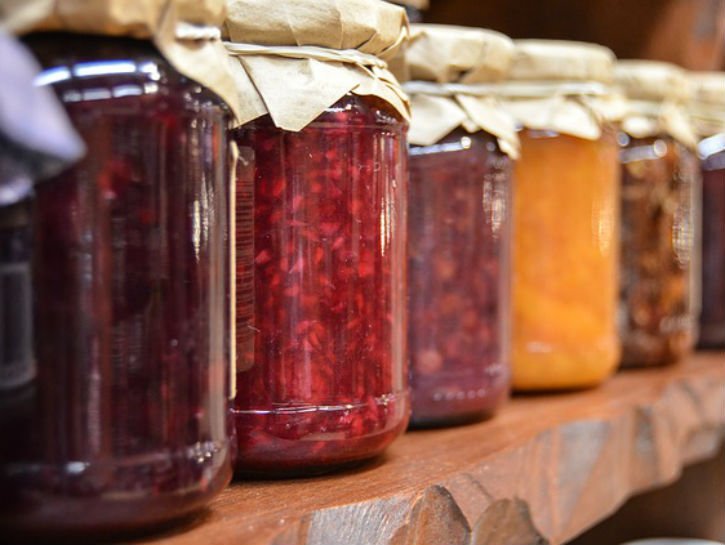Who doesn’t love a piece of toast with butter and jam or jelly? Fruit spreads are a popular part of any breakfast, with kids usually opting for jelly and adults choosing jam. The world of fruit spreads is rather confusing and sticky because most of us don’t know what distinguishes a jam from a jelly. They are the same, yet different, and it is important to know exactly what you are eating because of the different sugar contents and textures.

Jam and jelly start out pretty much identical, but they end up taking different paths to get to the final product. According to New Mexico State University’s College of Agricultural, Consumer, and Environmental Sciences, both jam and jelly are based on the same four basic ingredients — fruit, sweeteners, pectin, and naturally occurring acid.
The most important part of a jam or jelly is always the fruit. The fruit determines the flavor, the level of sweetness, and the texture. The sweeteners can vary from cane sugar to honey or corn syrup. The pectin is a carbohydrate and technically a separate ingredient, but in some fruits, it naturally exists in high levels.

Those are the basic similarities between jam and jelly, but the differences show up with the type of fruit, the proportions of the ingredients, and the way the fruit spread is prepared. The biggest difference between jelly and jam is that jelly is made from the juices of the fruit, and jam is made with crushed, whole fruits.
To get more specific, you make jelly by first crushing the fruit and then straining the juice. Then you boil the juice with more sugar and pectin, yielding a thick, jelly-like consistency.
With jam, the first step is the same as with the jelly, but the crushed fruit are left in with the finished product rather than being strained. Since mashed fruit often gives a good consistency for spreading, you don’t always have to add pectin to jam like you do with jelly.
Jam

What defines jam are the chunks of fruit left in it, giving it a lumpy consistency instead of smooth. If you are thinking about starting a canning business, the FDA says that to be sold as jam, the ratio must be 47 parts fruit to 55 parts sugar for oranges, berries, tomatoes, or pineapples.
However, for guava, currants or stone fruits, the ratio must be 45 parts fruit to 55 parts sugar. For a company to label and sell “jam,” it must have no less than 65 percent soluble solids.
The perfect jam is 45 percent fruit and 55 percent sugar, and you must cook the mixture until it thickens, so you can allow the fruit pieces to soften, making them smooth and spreadable. Jam is definitely a chunkier version of jelly, but with a looser, spoonable texture.
While there is a difference between jam and jelly, the FDA says that they consider jam and preserve to be the same thing. However, most people call a fruit spread a preserve when the fruit chunks are large, and a jam when the chunks are small and mashed. So, there really isn’t a difference between a jam and a preserve except for the amount of mashed fruit.
There is a difference, however, in how easy they are to spread. Since preserves often have such large chunks or even whole pieces of fruit, it can make them less than ideal to spread on a sandwich.
Some jams are also known as conserves, which is the name for a jam with several different varieties of fruit mixed together. They also sometimes include nuts mixed in.
Jelly

You are most likely to find jelly slathered with peanut butter on bread in your child’s lunchbox because it comes strictly from fruit juice, which means no solids. After boiling the juice and adding the sugar and pectin, it turns into a colored gel that has its own set of FDA guidelines. Basically, if you want to label and sell a “jelly,” it must have at least 55 percent fruit juice.
There are no seeds or pulp present in jelly, which makes it relatively clear. And it is the firmest type of fruit spread available. It is actually strong enough to slide out of its container in one solid piece if you turned it over.
Jellies use more pectin than jams to get the gel-like quality, and when making jelly, the fruits are usually cooked longer to capture the flavor.
And what about marmalade, you ask? While it may seem similar to a jam or preserves because of the tiny pieces of fruit, it is actually more closely related to jelly. You make marmalade by adding pieces of fruit rind — usually oranges — to a jelly mixture of citrus juice, sugar, and pectin.
When you are looking to add something sweet to a sandwich, a piece of toast, or a muffin, you definitely have options. All of these spreads are similar, with important distinctions, but every one of these spreads can ensure fruity goodness, no matter which one you choose.
